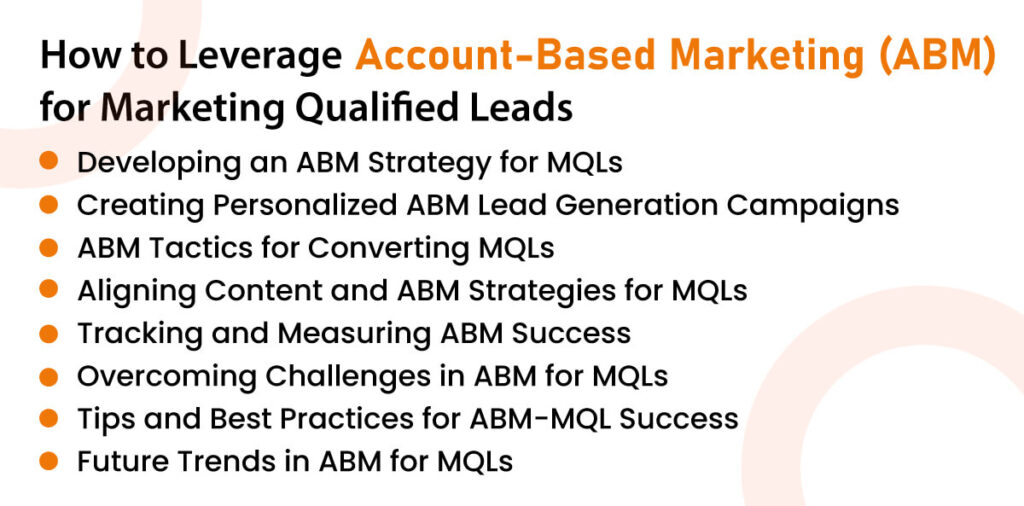
Account-Based Marketing (ABM) has emerged as a powerful strategy to target and engage high-value accounts, resulting in Marketing Qualified Leads (MQLs). Unlike traditional marketing approaches, ABM focuses on individual accounts, personalizing campaigns and content to resonate with specific prospects.
According to a study by Altera Group, 97% of marketers have stated that ABM has a higher ROI than other marketing initiatives, making it a top choice for businesses looking to drive revenue growth.
Must Read: The Role of AI in ABM: Enhancing Personalization and Efficiency
How to Leverage Account-Based Marketing (ABM) for Marketing Qualified Leads
Table of Contents
- 1 How to Leverage Account-Based Marketing (ABM) for Marketing Qualified Leads
- 1.1 Developing an ABM Strategy for MQLs:
- 1.2 Creating Personalized ABM Lead Generation Campaigns
- 1.3 ABM Tactics for Converting MQLs
- 1.4 Aligning Content and ABM Strategies for MQLs
- 1.5 Tracking and Measuring ABM Success
- 1.6 Overcoming Challenges in ABM for MQLs
- 1.7 Tips and Best Practices for ABM-MQL Success
- 1.8 Future Trends in ABM for MQLs
- 1.9 Share this:

Developing an ABM Strategy for MQLs:
To excel in ABM for MQLs, businesses must begin by aligning their sales and marketing teams. According to research by Sirius Decisions, B2B organizations with tightly aligned sales and marketing teams experience 24% faster revenue growth and 27% faster profit growth over a three-year period. Collaboration between teams is crucial to identify target accounts, segment prospects, and craft personalized messages that resonate with their pain points.
Must Read: Skyrocket your ROI: Discover the Most Effective Types of Account Based Marketing
Creating Personalized ABM Lead Generation Campaigns
Personalization is the heart of ABM for MQLs. A study by Evergage and Researchscape found that 98% of marketers believe that personalization advances customer relationships. Leveraging data insights, businesses can create tailored campaigns that address the specific needs and challenges of key decision-makers within target accounts. Personalized content, such as custom landing pages and tailored email sequences, significantly improves the likelihood of conversion.
Must Read: Best Account Based Marketing Tactics in 2023
ABM Tactics for Converting MQLs
Account-Based Marketing employs several tactics to convert MQLs into loyal customers. One effective tactic is using personalized direct mail, which, according to the DMA, achieves a 5.1% response rate, compared to just 0.6% for non-personalized mail. Additionally, retargeting ads can be deployed to reinforce brand messaging and maintain engagement with target accounts throughout their buying journey. Implementing a multi-touchpoint approach allows businesses to stay top-of-mind with prospects, ultimately driving conversions.
Must Read: Measuring the ROI of Your Account Based Marketing Strategy: Key Metrics to Track for Success
Aligning Content and ABM Strategies for MQLs
Content plays a pivotal role in ABM for MQLs. Research by the Content Marketing Institute reveals that 87% of B2B marketers say their organization bases content creation on specific stages of the buyer’s journey. Aligning content with ABM strategies ensures that prospects receive relevant and valuable information at each stage, guiding them towards making informed decisions. Engaging content that speaks to the individual needs of target accounts fosters trust and credibility.
Must Read: MQL to SQL Conversion Rate
Tracking and Measuring ABM Success
Account-Based Marketing’s success lies in its ability to measure results accurately. Using data analytics, businesses can assess the performance of ABM campaigns and refine their strategies accordingly. Key metrics to track include engagement levels, lead conversion rates, and revenue generated from target accounts. According to a survey by ITSMA and the ABM Leadership Alliance, 91% of marketers say ABM increases the average deal size, demonstrating its effectiveness in driving higher-value deals.
Must Read: Important Ways to Generate Marketing Qualified Leads
Overcoming Challenges in ABM for MQLs
While ABM for MQLs yields impressive results, it comes with its share of challenges. According to a study by Demandbase and Ascend2, 60% of marketers cite data quality as the top barrier to successful ABM implementation. Ensuring accurate and up-to-date data is crucial for personalized targeting and messaging. Additionally, maintaining consistent communication and alignment between sales and marketing teams is vital to navigating the complexities of ABM effectively.
Must Read: Top Reasons to Hold On to MQLs: They Will Convert Eventually If Marketing Is Done Correctly
Tips and Best Practices for ABM-MQL Success
To achieve success with ABM for MQLs, businesses should adopt a few best practices. Conduct thorough research on target accounts to gain insights into their preferences and needs. Leveraging artificial intelligence (AI) and machine learning can enhance data analysis and segmentation, leading to more effective ABM campaigns. Regularly evaluate and optimize strategies based on data-driven feedback and maintain an agile approach to adapt to changing market dynamics.
Must Read: Build A Strong ABM Campaign With Account Mapping Techniques
Future Trends in ABM for MQLs
As technology continues to evolve, ABM for MQLs is set to witness some exciting trends. The integration of AI and predictive analytics will streamline the identification of potential MQLs, making the targeting process more precise. Moreover, the rise of video marketing and interactive content will add new dimensions to personalized ABM campaigns, increasing engagement and conversion rates.
Must Read: The Importance of Account-Based Marketing: Past, Present, and Future
Conclusion
Account-Based Marketing for MQLs is a game-changer in B2B marketing. By embracing personalized ABM lead generation strategies, aligning content with target accounts, and effectively measuring campaign success, businesses can reap substantial rewards in terms of revenue growth and customer loyalty. To thrive in a competitive landscape, organizations must embrace the power of ABM, building strong relationships with high-value accounts and positioning themselves for long-term success in the market.

Vikas Bhatt is the Co-Founder of ONLY B2B, a premium B2B lead generation company that specializes in helping businesses achieve their growth objectives through targeted marketing & sales campaigns. With 10+ years of experience in the industry, Vikas has a deep understanding of the challenges faced by businesses today and has developed a unique approach to lead generation that has helped clients across a range of industries around the globe. As a thought leader in the B2B marketing community, ONLY B2B specializes in demand generation, content syndication, database services and more.


